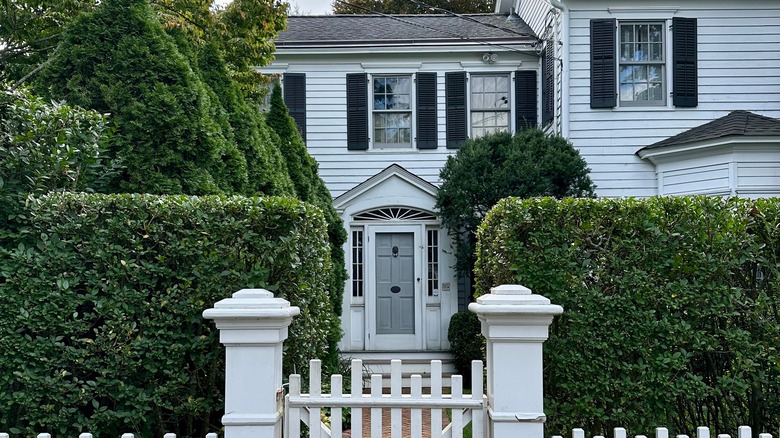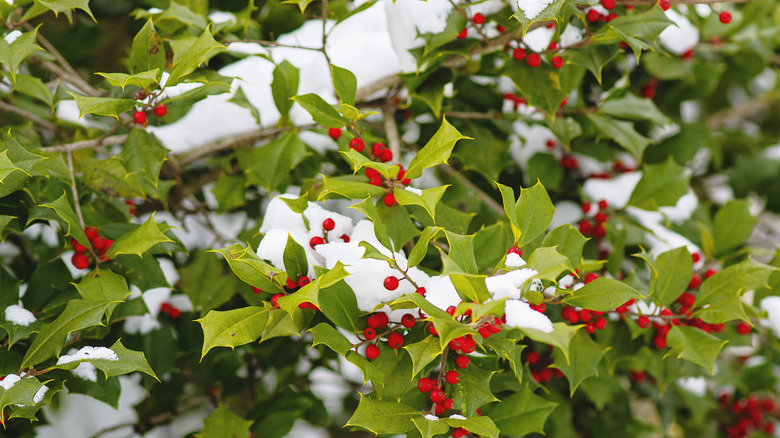The Fast-Growing Privacy Tree That's Popular In The Hamptons (& Reasons To Avoid It)
The wealthy Long Island, New York beach communities that make up the Hamptons often use fast growing shrubs and trees to protect their privacy from beach goers. This desire for privacy is understandable, considering the number of beautiful celebrity homes in the Hamptons. While there are a lot of fun ways to emulate their style and decorate your home like you're in the Hamptons, one iconic Hamptons look is likely best avoided –the California privet (Ligustrum ovalifolium) hedge.
Despite the name, California privet is not native to California or anywhere else in North America. It is instead native to Japan. Considering California privet's ability to quickly create a tall and dense living fence, it's no surprise that it's a popular option for people looking for beautiful ways to create privacy. Unfortunately, those same features that make it desirable for privacy, have also made it an invasive pest that can quickly take over natural spaces and outcompete native plants in many parts of North America.
While there are many different privet species, almost all are considered invasive and some are even prohibited in many states. In addition to its damage to the environment, privet also has toxic leaves and berries, making it a risk to have around children or pets. Its seeds are often spread by birds and other wildlife as well, so the plant could easily spring up in unexpected places if it's growing in or near your yard. Instead of dealing with the headache of removing privet, it's best to avoid it in the first place and opt for native or non-invasive plants for privacy instead.
Removing privet hedges
If you already own a home with a privet hedge and are considering removing it in favor of a different living fence, be aware that removing privet can be a challenging, but worthwhile task. While getting rid of fast growing privet isn't easy, it's also not impossible. For small patches, you may be able to dig or pull up the plants by hand or with the help of a shovel. Be sure to remove the roots as well to prevent regrowth.
You may need to turn to herbicides to fully eliminate your privet problem, as it can be extremely persistent. If you opt to use an herbicide, be sure to carefully read the label and follow all instructions carefully. Cutting back the privet and then painting the stumps with an herbicide is often an effective strategy.
Non-invasive and native privet alternatives
The problems with privet don't mean you have to give up your privacy though. Many other shrubs and plants can block views of your home and yard without the invasive issues privet brings. Boxwoods (Buxus spp.), generally lack privet's invasive tendencies, while still creating elegant hedges with year-round color. Hardy in zones 5 through 9, boxwood is unfortunately toxic, so it may not be the right privet alternative for those with pets or toddlers.
Another good hedge you can plant for privacy in your yard is holly (Ilex spp.). You can even opt for growing the beautiful and evergreen American holly (Ilex opaca) if you want to use a native plant as a privacy hedge. While American holly is slow growing, it can eventually grow quite tall, and makes an excellent privacy screen that also benefits native birds and pollinators. If you want the bright red berries holly is so known for, be sure to purchase both male and female plants, and remember that only the females produce berries. Additionally, these berries are toxic, so it may be best to avoid them if you have young children. Hardy in zones 5 through 9, American holly can be an ideal privet alternative.


